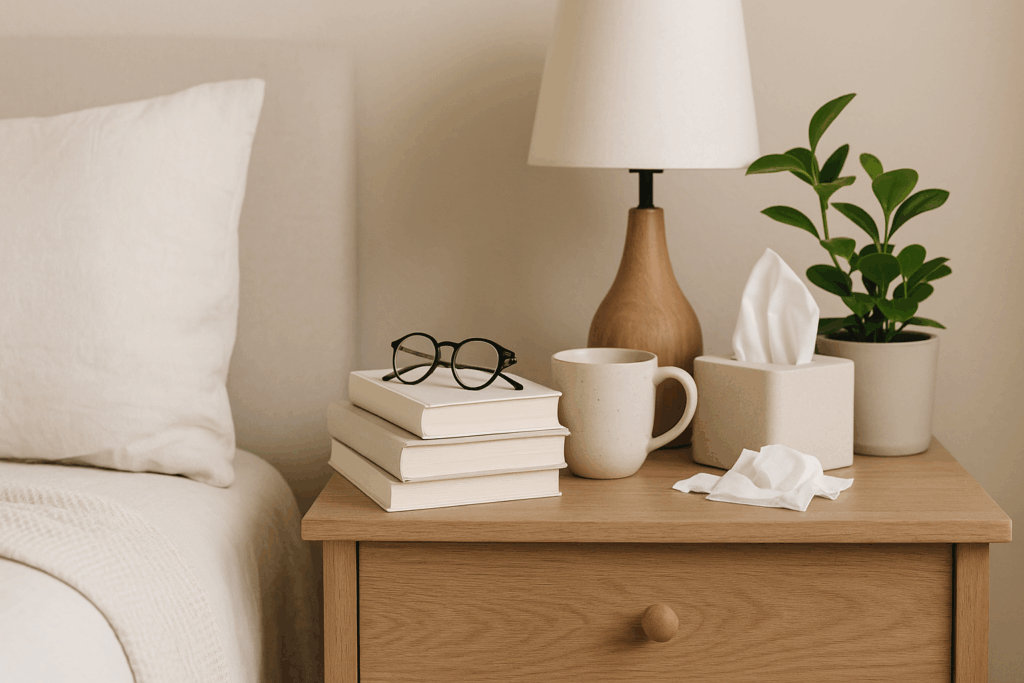Let’s be honest: my bedside table has seen it all. Half-read books. Empty water glasses. Hair ties, receipts, cough lozenges, one sad sock… Somehow, this tiny surface becomes the catch-all for everything I haven’t dealt with yet.
If you’re anything like me (i.e. human), you’ve probably whispered, “I’ll sort this later,” while shoving another thing onto your bedside pile. But here’s the thing—tidying your bedside table is powerful. It’s one of the quickest ways to reclaim a little pocket of calm, especially when life feels anything but calm.
Why Start At The Bedside Table?
In my coaching practice, I often suggest people start their decluttering journey with their bedside table. Not because it’s the messiest spot, but because it’s yours.
Not the family room. Not the pantry your partner “organised” with empty ice cream tubs. Your bedside table. Your space.
It’s a quiet rebellion against putting yourself last. A small, intentional act that says, “I matter too.”
And bonus? It’s a manageable project. No need to clear your calendar or hire a skip bin.
“This is the first space you see in the morning and the last one you see at night. It should feel like a sanctuary. A place that bookends your day with calm. It quietly sets the tone for how you wake up and how you wind down. And that matters more than we give it credit for.”
Also—keep this in mind as you start. That little table isn’t just furniture—it’s a daily rhythm setter. As this Homes & Gardens article explains, creating a calm, minimalist space can reduce stress, support better sleep, and signal safety to the nervous system. A tidy bedside table might be a small start, but its impact is big.

Step One: Ditch the Guilt (and the Junk)
Before you even touch the table, give yourself permission to let go of the weird guilt that clutter can bring. You’re not lazy. You’re not a mess. You’re just a person with a lot going on.
Now, take everything off your bedside table. Yes, everything. Lay it out somewhere visible—a bed, a tray, the floor if necessary. Seeing it all in one place makes decision-making easier.
Then, sort quickly:
- Keep: Stuff you use nightly or love deeply (lip balm, journal, lamp)
- Relocate: Things that belong elsewhere (like your kid’s Pokemon cards, that broken lightsabre, or 5 of the 6 half full water glasses or coffee mugs)
- Let go: Trash, duplicates, or items that make you feel meh
Keep the momentum. Don’t pause to reminisce over that festival wristband from 2012 (unless it sparks real joy à la Marie Kondo, in which case, sure).
Step Two: Curate Your Bedside Table with Purpose
This is where the D.C.L.T.R. magic happens. Specifically, the Curate step—choosing what belongs in your space based on the life you want.
Ask yourself:
- Do I need this here?
- Does it serve me now?
- Is it helping me feel calm, comforted, or inspired?
If the answer’s no, off it goes. You deserve a bedside table that supports your rest, not one that yells “unfinished tasks!” at bedtime. Craft projects and to-read piles are especially notorious for this kind of passive-aggressive energy.
Step Three: Set Yourself Up to Win
Let’s make it easy to keep your table tidy. A few dopamine-friendly hacks:
- Use containers: A small dish for jewellery. A soft box for sleep sprays or pens.
- Limit surface clutter: Keep the surface as clear as possible. Everyone’s threshold is different, but the goal is to create a space that feels calm, not chaotic. Give each item a clear “home” so it doesn’t drift into clutter territory.
- Light matters: If you can, swap your harsh lamp for one with a soft glow. Mood = transformed.
This isn’t about aesthetic perfection—it’s about setting up a little nightly sanctuary.
Step Four: Rethink the Function of the humble Bedside Table
Not everyone uses their bedside the same way. Are you a:
- Reader? By all means keep a small to-read pile if it feels good to you! Add an e-reader stand or keep your current read close at hand.
- Notetaker? Keep a journal and pen handy.
- Meds-at-midnight type? Keep them right on the table if that works for you. Sure, they might not be pretty—but function matters more than aesthetics, especially for visual folks.
Let the table work for you, not just collect stuff from you.
Step Five: Reset Often, Guilt-Free
Even if you nail it today, life will life. That surface might get messy again. That’s okay.
Set a gentle rhythm—a weekly or fortnightly reset. I like to combine it with changing my pillowcases. No pressure, just a small routine to reclaim the space. You can also build in a micro-reset: when you leave the room in the morning, take last night’s tea cup or dirty tissues with you. Little habits like this help the whole room stay tidier for longer.
And remember: progress beats perfection every time.
Ready to Try?
You don’t need to declutter your whole house today. Just start with this one little space.
For more support (and a bit of hand-holding, if needed), join a Side-by-Side Session or grab practical tips from The Simplicity Toolkit.
You’ve got this.
